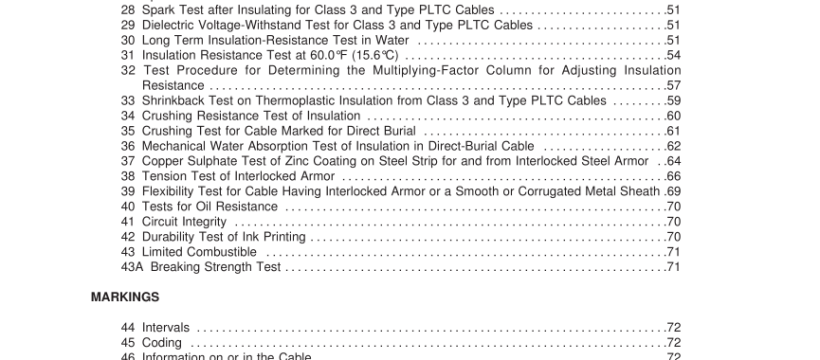UL 13-2011 pdf download.Power-Limited Circuit Cables.
4 Materials 4.1 Each material used in a cable shall be compatible with all of the other materials used in the cable. 4.2 Power-limited circuit cable shall comply in all respects with the applicable requirements for construction details, test performance, and markings. 5 Conductors 5.1 Conductors shall comply in size (see 5.2) and material with Table 5.1 . The nominal diameters of solid and stranded conductors which are 30 – 6 AWG conductor size, that are indicated in Table 5.2 and Table 20.1 in UL 1 581 when conductor size is smaller than 30 AWG, are to be used in calculating the dimensions required for various parts of the cable when using Tables 1 3.1 , 1 3.2, 1 3.3, 1 4.1 , 1 4.2, 1 5.1 , and 1 8.1 . The length of lay of the wires (strands) of a bunch-stranded conductor shall not exceed 20 times the calculated diameter over the assembled conductor for 1 9 – 6 AWG conductors and shall not exceed 30 times the calculated diameter over the assembled conductor for 30 – 20 AWG conductors. For a bunch-stranded member of a rope-lay conductor, the length of lay of the individual strands within the bunch shall not be more than 30 times the outside diameter of the member. The length of lay of the member in the outer layer of a rope-lay conductor shall be 8 – 1 6 times the outside diameter of that layer.
5.2 All solid and stranded conductors are to be identified in the cable, tag, reel, or carton size markings as a particular AWG size. The size of a solid conductor shall be verified either by determination of the d-c resistance or, as described in 5.6, by determination of the diameter. The size of a stranded conductor shall be verified either by determination of the d-c resistance or by determination of the cross-sectional area as described in 5.6. Determination of the conductor size by measurement of the d-c resistance is to be as described in D-C Resistance Test of Copper Conductors, Section 1 7, and Table 30.1 – 30.1 1 in UL 1 581 when conductor size is smaller than 30 AWG, and is the referee method in all cases. 5.2 revised January 31 , 201 1 5.3 Each conductor shall be continuous throughout the entire length of the finished cable – see test in 1 5A.1 and 1 5A.2.
5.4 A joint in a solid conductor or in one of the individual wires of a stranded conductor shall be made in a workmanlike manner, shall be smooth, and shall not have any sharp projections. A joint in a stranded conductor is to be made by separately joining each individual wire, or is to be made by machine brazing or welding of the conductor as a whole provided that the resulting solid section of the stranded conductor is not longer than 1 /2 in or 1 3 mm, there are no sharp points, and the distance between brazes or welds in a single conductor does not average less than 3000 ft or 91 5 m in any reel length of insulated single conductor. A joint made before insulation is applied to a conductor shall not increase the diameter of the solid conductor or individual wire (strand). A joint made after insulating shall not increase the diameter of the solid conductor or individual wire (strand) by more than 20 percent. Joints made after insulating shall be made prior to further processing and shall be insulated by heat-shrinkable tubing or by applying the original or investigated comparable insulation by means of a bonded patch or molding, and shall comply with the requirements in this Standard. A jacket that is damaged to the point that the underlying assembly is exposed or that is opened for the purpose of repairing a conductor either: a) Shall be stripped and replaced in its entirety, or b) A second, duplicate jacket shall be applied over the first for the entire length of the cable. The total jacket thickness shall not exceed any limitation determined for a particular cable in an applicable flame or smoke-and-flame test or other test specified in this Standard. 5.5 Any section of conductor that includes a factory joint shall have a tensile strength that is not less than 85 percent of the tensile strength of an adjacent section of the conductor without a joint.UL 13-2011 pdf download.
UL 13-2011 pdf download
